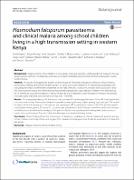| dc.description.abstract | Background: Malaria among school children is increasingly receiving attention, yet the burden of malaria in this age group is poorly defined. This study presents data on malaria morbidity among school children in Bungoma county, western Kenya.
Method: This study investigated the burden and risk factors of Plasmodium falciparum infection, clinical malaria,
and anaemia among 2346 school children aged 5–15 years, who were enrolled in an individually randomized trial
evaluating the effect of anthelmintic treatment on the risks of malaria. At baseline, children were assessed for anaemia and nutritional status and information on household characteristics was collected. Children were followed-up for 13 months to assess the incidence of clinical malaria by active detection, and P. falciparum infection and density evaluated using repeated cross-sectional surveys over 15 months.
Results: On average prevalence of P. falciparum infection was 42 % and ranged between 32 and 48 % during the five cross-sectional surveys. Plasmodium falciparum prevalence was significantly higher among boys than girls. The overall incidence of clinical malaria was 0.26 episodes per person year (95 % confidence interval, 0.24–0.29) and was significantly higher among girls (0.23 versus 0.31, episodes per person years). Both infection prevalence and clinical disease varied by season. In multivariable analysis, P. falciparum infection was associated with being male, lower socioeconomic status and stunting. The risk of clinical malaria was associated with being female.
Conclusion: These findings show that the burden of P. falciparum parasitaemia, clinical malaria and anaemia among school children is not insignificant, and suggest that malaria control programmes should be expanded to include this age group. | en_US |


